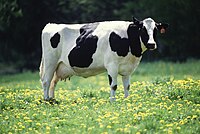
Photo from wikipedia
The objective of the present study was to quantify the relationship between udder skin surface temperature (USST) and somatic cell count (SCC) in lactating dairy cows. Data were recorded on… Click to show full abstract
The objective of the present study was to quantify the relationship between udder skin surface temperature (USST) and somatic cell count (SCC) in lactating dairy cows. Data were recorded on the same 14 Holstein-Friesian cows, at evening (15:00 to 16:00) milking every day over a 2-mo period. Surface temperature measurements of all udders were extracted from thermal images. After imaging, milk was extracted from each quarter and analyzed for SCC. Environmental and cow-related factors (i.e., ambient temperature, humidity, rainfall, wind speed, distance walked to the parlor, number of days since the udder was shaved, parity, and stage of lactation) were recorded on each day of the experiment. A large array of descriptive temperature parameters (DTP) were extracted from every udder image including temperature-based (e.g., maximum, average and minimum USST), pixel count-based, and textural-based DTPs. Several different analytical methods were tested in an attempt to relate any given DTP to SCC; this included investigating the relationship between USST and the log transform of SCC (i.e., somatic cell score; SCS). The temperature range within each udder was also compared with the natural log of the range in SCC of the respective quarters. In a separate analysis, the temperature difference between each DTP and its respective daily baseline (i.e., average of the 5 lowest values of that DTP across the herd) was compared with SCS. Finally, the association between environmental and cow-related factors with each DTP was investigated to create prediction models for each DTP, the residuals of which were compared with SCC. Results from the present study indicate that the correlation between any DTP and SCS was weak (range of -0.16 to 0.19) and so could not be used to identify quarters with high SCC. Although some alternative measures had a significant relationship with SCS, again, the correlation was too weak for practical use on its own. Maximum and average USST could be predicted with a root mean square error of 0.23 and 0.35 °C, respectively, although the residuals from the prediction model could not be used to identify animals with high SCC. This suggests that infrared thermography alone could not be used as a real-time automated tool to detect high SCC for dairy cows in a pasture-based system.
Journal Title: Journal of animal science
Year Published: 2018
Link to full text (if available)
Share on Social Media: Sign Up to like & get
recommendations!